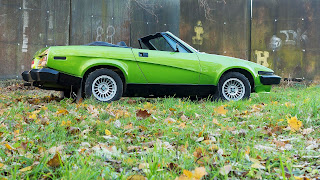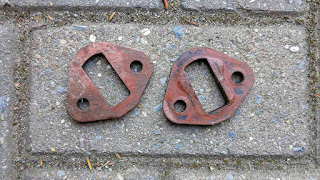Today it was exactly 30 years ago that I bought my very first car, an at the time still
original Dutch Triumph TR7 DHC. The car was first registered on the 6th
of June 1980, and left the factory in Platinum Grey (MCA) with a Navy Blue
velour interior (JAJ). Fast
forward 30 years and the car is still in my possession, and still going strong.
Partly thanks to a full restoration which started a few days after Christmas
2008 and was finished in June 2010. And despite its current fuelling problems, I
still haven't got tired of this car after all those years! Time to celebrate
with some pictures of the car.
As the
looks and the mechanics of the car didn't change much during the first 20 years
in my ownership, I'll stick to pictures from her current guise. For some older
pictures please go to this post from 21 of
August 2008 😋. To start
with some pictures of the car just after its restoration was finished in the
summer of 2010, including testing various wheel options:
But where
she has really excelled so far is as a (long distance) touring car. With tours
ranging from short trips in the area to 3000+ kilometre trips into the Alps,
including its shake down run in the summer of 2010. So below is a selection of
my favourite pictures of the car during various tours across Europe since her
restoration was finished:
On her
maiden trip in the summer of 2010,
and what better place to start than at some
nice Alpine passes:
2010-08-06
On top of a damp and cold Timmelsjoch,
close to the border between Austria and
Italy.
2010-08-08
A few days later and back to the Timmelsjoch,
hoping for better weather
conditions. It wasn't meant to be'!
2010-08-09
On top of the Albula Pass (CH)
During her
second Alpine tour in the summer of 2011:
near the top of the Passo Pordoi.
2011-07-15
On top of the legendary Stilfserjoch.
Club
Triumph's 2011 edition of the 10 Countries Run:
2011-09-08
Enjoying a short rest at the motorway services on the A31 near Loisy (F).
to enjoy a lovely sunrise on top of the Sankt
Gotthard Pass (CH).
Club
Triumph's 2013 edition of the 10 Countries Run:
2013-09-04
In the market square of the small village of Watou (B),
on the evening before
the start of the event.
2013-09-05
At the Circuit de Reims (F).
2013-09-06:
Near the summit of the Col de la Bonette (F).
2014
During the 2nd edition Club Triumph's Taith o Amgylch Cymru
(or a Tour of
Wales):
2014-05-10
At the dam of the Nant-y-Moch Reservoir.
2014-05-11
On top of the Black Mountain.
Club
Triumph's 2015 edition of the 10 Countries Run:
2015-09-11
Near the summit of the Grossglockner Hochalpenstrasse (A).
2015-09-12
At the summit of the Silvretta Hochalpenstrasse (A).
Club
Triumph's 2017 edition of the 10 Countries Run:
2017-09-06
Enjoying a short rest,
on the roadside of the N88 just outside Chenois (B).
2017-09-07
On top of the Oberalp Pass (CH).
And
finally some pictures taken during some recent local tours:
2017-04-19
Enjoying one of the first fine spring days of the year,
Elkenrade (NL).
2017-04-19
and near Gereonsweiler (D).
2017-11-22
Late autumn in Belfeld (NL).
2017-11-22
Late autumn in Belfeld (NL).
2018-05-05
Old road along the west bank of the River Meuse,
near Kessel (NL).
2018-06-20
Enjoying a fine late spring's evening,
Kasteel Hillenraedt, Swalmen (NL).





















































